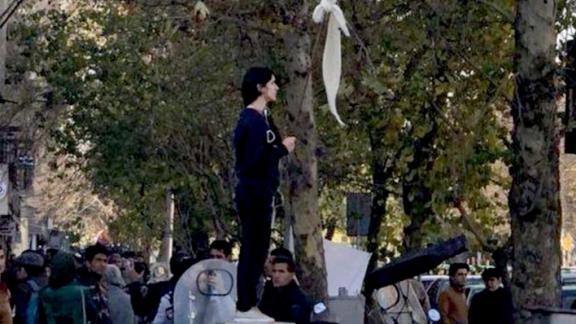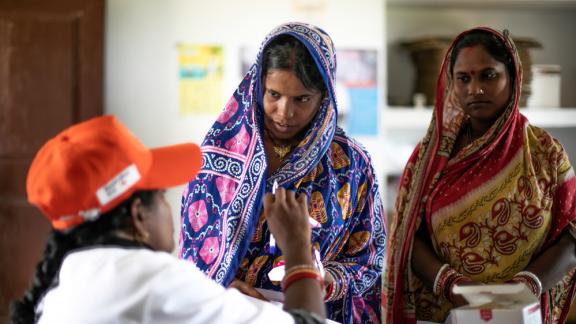Seen in picture: Vida Movahed, an Iranian woman who inspired anti-hijab protests by removing her obligatory Islamic head scarf in a public gesture of defiance in December 27, 2017
First drafted in 2022 amidst the uprising sparked by the death of 22-year-old Jina Mahsa Amini while in the custody of Iran’s “Morality Police”, the so-called “Hijab and Chastity Bill” was passed in the Iranian Islamic Parliament, Majlis, on November 30th, 2024.
The law has received widespread criticism and condemnation from the public, civil rights activists and advocates, leading it to be discussed and finalised behind closed doors contrary to standard legislative procedures. The sweeping legislation, which includes 5 chapters and 72 divisions, is made up of guidelines for all government and state departments, ministries, and institutions, as well as civil organisations, independent businesses, schools and universities.
The legislation enables the use of image processing and CCTV cameras to enforce the law in all public places, both online and offline. It is a blanket imposition of a way of life and presence in public, most adversely impacting women and LGBTQIA+ communities and other marginalised groups, especially in rural areas of the country.
While the disbanding of the ‘Morality Police’ via a government announcement, following Jina Amini’s killing was cheered by some, activists had warned of the centrality of mandatory Hijab for the Islamic Regime of Iran since its creation.
when
region
South Asia

What is the most shocking in the recently passed ‘Hijab and Chastity’ law is the clear and strong criminalisation of any attempt at defying the strictly imposed dress code, punished by heavy fines, being blocked from receiving social services, potential jail time, or a ban on social activities online and offline.

Appearing without the hijab online or in public spaces, or promoting such behaviour online or offline, making fun of, or being seen as insulting hijab online or offline, committing or tolerating such behaviour at the workplace, schools and universities - is punished by heavy fines, being blocked from receiving social services, potential jail time, or a ban on social activities online and offline.
This strict enforcement of the authorities’ preferred design of the hijab is accompanied by heavy subsidies to businesses, institutions, and individuals that promote the state’s recommended lifestyle. Rebuking the long-lasting and ongoing battle of Iranian women and girls with the regime’s intrusions, these subsidies also include textile businesses that import, design, and sell ‘appropriate’ attire for the public, while punishing and banning those that offer alternative designs.
Furthermore, media companies that propagate the “Islamic lifestyle” particularly focused on the heteronormative, nuclear family, chastity and gender binary; and academic institutions prioritising research into the importance of the nuclear family and “Islamic values” related to hijab, chastity, and relationships are promoted. In contrast, any media criticizing the law and the values it upholds, particularly sharing information on LGBTQIA+ rights are criminalized and censored.

The expansive scope of the legislation, together with other recently passed laws taking aim at reproductive rights, underscores the Iranian state's intent to restrict people’s freedom of choice and autonomy over their bodies, gender expression, public life and social activities.

Like all such restrictive rules, this newest addition is sure to impact the most marginalised groups the worst: minorities in rural and poorer areas of the country, gender-diverse individuals, victims and survivors of domestic violence. The harsher restrictions on comprehensive sexuality education (CSE) and services are particularly worrying given the rising rates of transmission of Sexually Transmitted Infections (STIs), including HIV and HPV, especially among women. The lack of any kind of education on safe sex, coupled with the new criminalisation of choice, puts individuals at greater risk.
The Iranian legislation has consistently failed to uphold and safeguard women’s rights. Notably, a bill aiming at upholding women’s safety against violence, which includes raising the minimum age of marriage for girls to 18, has been making the rounds in government halls for almost a decade without being voted on to become law. This, while official statistics show an increase in instances of femicide under the guise of ‘honour killings’ by 1 woman or girl killed every four days by a current or former “male” family member. The reports also show a rise in sexual and domestic violence, although they do not include Sexual and Gender Based Violence results of child marriages, which remain legally protected in Iran.
Unfortunately, the new law seems unconcerned with the current worsening situation in the country, instead doubling down on restrictions that, far from helping marginalised groups, is sure to bring more harm. With the struggle for the freedom of choice on one’s body, way of being and way of life in the spotlight, this law is yet another reminder of the global and universal nature of the struggle and the importance of solidarity among all, regardless of religion, social standing, race, or geography.
This blog is authored by the Feminist Spectrum team, Iran. Spectrum is a queer feminist, non-profit organisation which informs and advocates for Love, Fairness and Equality.











